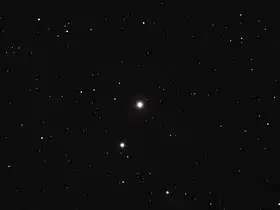 19 Draconis in optical light | |
| Observation data Epoch J2000 Equinox J2000 | |
|---|---|
| Constellation | Draco |
| Right ascension | 16h 56m 01.68925s[1] |
| Declination | +65° 08′ 05.2631″[1] |
| Apparent magnitude (V) | 4.89[2] |
| Characteristics | |
| Spectral type | F8V[3] |
| U−B color index | -0.03[2] |
| B−V color index | +0.485[2] |
| Astrometry | |
| Radial velocity (Rv) | −21.00 ± 0.8[4] km/s |
| Proper motion (μ) | RA: 237.79[1] mas/yr Dec.: 50.84[1] mas/yr |
| Parallax (π) | 65.54 ± 0.33 mas[1] |
| Distance | 49.8 ± 0.3 ly (15.26 ± 0.08 pc) |
| Absolute magnitude (MV) | 3.98[5] |
| Orbit[5] | |
| Period (P) | 52.1089 ± 0.0001 d |
| Semi-major axis (a) | 20.0 mas |
| Eccentricity (e) | 0.2221 ± 0.0002 |
| Inclination (i) | 90.5 ± 2.2° |
| Longitude of the node (Ω) | 23.5 ± 2.0° |
| Periastron epoch (T) | JD 2453427.880 ± 0.007 |
| Argument of periastron (ω) (secondary) | 338.46 ± 0.05° |
| Semi-amplitude (K1) (primary) | 17.465 ± 0.004 km/s |
| Details[5] | |
| 19 Dra A | |
| Mass | 1.04 M☉ |
| Radius | 1.2 R☉ |
| Luminosity | 2.02 L☉ |
| Temperature | 6298 ± 80 K |
| Metallicity | Z = 0.013 ± 0.004 |
| Age | 4.7 Gyr |
| 19 Dra B | |
| Mass | 0.37 M☉ |
| Radius | 0.3 R☉ |
| Luminosity | 0.02 L☉ |
| Temperature | ~3963[note 1] K |
| Other designations | |
| Database references | |
| SIMBAD | data |
| ARICNS | data |
19 Draconis, also known as h Draconis, is a star system in the constellation Draco. It is visible to the naked eye as a faint, yellow-white hued star with an apparent visual magnitude of 4.89.[2] Based on its parallax, the system is located about 49.8 light-years (15.26 parsecs) away.[1] It is moving closer to the Earth with a heliocentric radial velocity of −21 km/s.[4]
This is a binary star system with an orbital period of 52.1 days and an eccentricity of 0.22. Only the primary star can be directly detected, via Doppler shifts or perturbations around the system's barycenter. Using spectroscopy and astrometry, the nature of the secondary star can be inferred. The primary star is an F-type main-sequence star with a stellar classification of F8V,[3] 4% more massive than the Sun. Its surface temperature is about 6,298 K, and it emits just over twice the amount of energy that the Sun does. The secondary is only 37% as massive as the Sun, and its luminosity is only 2% that of the Sun. The system is about 4.7 billion years old.[5]
References
- 1 2 3 4 5 6 van Leeuwen, F.; et al. (2007). "Validation of the new Hipparcos reduction". Astronomy and Astrophysics. 474 (2): 653–664. arXiv:0708.1752. Bibcode:2007A&A...474..653V. doi:10.1051/0004-6361:20078357. S2CID 18759600.
- 1 2 3 4 Mermilliod, J.-C. (1986). "Compilation of Eggen's UBV data, transformed to UBV (unpublished)". Catalogue of Eggen's UBV Data. Bibcode:1986EgUBV........0M.
- 1 2 Abt, Helmut A. (2009). "MK Classifications of Spectroscopic Binaries". The Astrophysical Journal Supplement. 180 (1): 117–18. Bibcode:2009ApJS..180..117A. doi:10.1088/0067-0049/180/1/117. S2CID 122811461.
- 1 2 Gontcharov, G. A. (2006). "Pulkovo Compilation of Radial Velocities for 35 495 Hipparcos stars in a common system". Astronomy Letters. 32 (11): 759–771. arXiv:1606.08053. Bibcode:2006AstL...32..759G. doi:10.1134/S1063773706110065. S2CID 119231169.
- 1 2 3 4 Wang, Xiaoli; Ren, Shulin; Fu, Yanning (2015). "Self-Consistent Orbits and Physical Properties for Eight Single-Lined Spectroscopic Binaries". The Astronomical Journal. 150 (4): 110. Bibcode:2015AJ....150..110W. doi:10.1088/0004-6256/150/4/110.
Notes
- ↑ From L = 4πR2σTeff4, rearranging to make Teff = (L / 4πR2σ)1/4. Where L is the luminosity, R is the radius, Teff is the effective surface temperature and σ is the Stefan–Boltzmann constant.